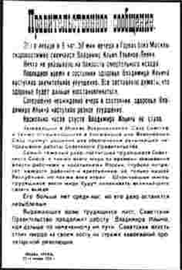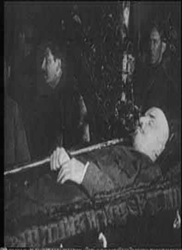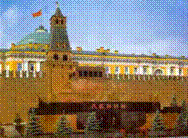


Bulletin Lenin's Death January 21, 1924 Stalin at Vigil Lenin's funeral Lenin Mausoleum
Where We Stand: Lenin’s Mummification — Preliminary Step in the Building of the Personality Cult
 Organ of Alliance Marxist-Leninist
(North America) Volume
1, Issue 8; October 2003 $1.00
Organ of Alliance Marxist-Leninist
(North America) Volume
1, Issue 8; October 2003 $1.00



Bulletin Lenin's Death January 21, 1924 Stalin at Vigil Lenin's funeral Lenin Mausoleum
Where We Stand: Lenin’s Mummification — Preliminary Step in the Building of the Personality Cult
The Death of Lenin and the Funeral CommissionOn 21 January 1924, Lenin died. The Central Executive Committee formed a Funeral Commission – headed by Felix Dzerzhinsky, with the following members: Muralov, Lashevich, Bonch-Bruevich, Voroshilov, Molotov, Zelensky and Yenukidze. Stalin, who also called for steps to maintain calm, informed all regional Party Committees. The Funeral Commission proposed extending the lying-in state period at the Kremlin. Consequently, A.I.Abrikosov performed a normal embalming that would suffice to forestall putrefaction for 6-7 days.
“persuade Nadezhda Konstantinova: if she will not agree not to insist on acceptance of her proposal, the question can be discussed again in a month”;At the same time it instructed that:
Volkogonov D; Lenin – A New Biography; New York 1994; p.440; p. 437; citing APRF, f.3, op.22, d.309, il.15, 16, 21.
“1) The coffin containing V.I.Lenin’s corpse is to be kept in a vault which should be made accessible to visitors;Lenin’s state funeral was held on the 26 January.
2) The vault is to be formed in the Kremlin wall on Red Square among the communal graves of the fighters of the October revolution. A commission is being created today for the construction of a mausoleum (temporary for now). Academician A.B.Shchusev is commissioned to prepare drawings for the mausoleum”;
Ibid., pp.437-438.
“Having created their relic, the Bolsheviks had taken the first decisive step towards turning Lenin's ideas into a secular religion; a religion, moreover, comparable in the unquestioning obedience of its adherents only to the faith of fanatical fundamentalists……. The first decrees of the Central Committee after Lenin's death affirmed that the Party leadership in its struggle to build the Communist society' would make Lenin's mummy and everything associated with it one of the most important tools for accomplishing the task.”Unsurprisingly this line takes its’ cues from Trotsky. It was Trotsky’s view that since Stalin’s first education had been in a Georgian seminary for the priesthood, Stalin was in essence a ‘religious’ and anti-Bolshevik, a crude unsophisticate. This line was more widely popularised by Trotsky’s followers such as Isaac Deutscher. Deutscher portrays Stalin’s eulogy to Lenin, delivered on January 26th 1924, at the Second All-Union Congress of Soviets as a religious invocation:
Ibid., pp.440, 441.
“It is perhaps natural that the triumvir who had spent his formative years in a Greek Orthodox seminary should become the foremost agent of that change, that he should give the fullest expression to it. The oath to Lenin, which he read at the second congress of the Soviets, remains to this day the fullest and the most organic revelation of his own mind. In it, the style of the Communist Manifesto is strangely blended with that of the Orthodox Prayer Book; and Marxist terminology is wedded to the old Slavonic vocabulary. Its revolutionary invocations sound like a litany composed for a church choir.Continued on page eight.
Deutscher goes on to quote from Stalin's speech:
The Second view: On the other and second hand, the view is put that this was a simple method of ensuring that the masses (of the then present, but also of later times) wish, to pay some recognition to him, was enabled:
‘Comrades, we Communists are people of a special cut. We have been cut out of peculiar stuff... There is no loftier title than that of a member of the party, of which Comrade Lenin has been founder and leader. . .
In leaving us, Comrade Lenin ordained us to hold high and keep pure the great title of member of the party. We vow to thee, Comrade Lenin, that we shall honourably fulfil this thy commandment. . .
In leaving us, Comrade Lenin ordained us to guard the unity of our party like the apple of our eye. We vow to thee, Comrade Lenin, that we shall fulfil honourably this thy commandment, too. . .
In leaving us, Comrade Lenin ordained us to guard and strengthen the dictatorship of the proletariat. We vow to thee, Comrade Lenin, that without sparing our strength we shall honourably fulfil this thy commandment, too. . .
In leaving us, Comrade Lenin ordained us to strengthen with all our might the alliance of workers and peasants. We vow to thee, Comrade Lenin, that we shall fulfil honourably this thy commandment, too. . .
In leaving us, Comrade Lenin ordained us to strengthen and broaden the Union of the Republics. We vow to thee, Comrade Lenin, that we shall honourably fulfil this thy commandment, too. . .
In leaving us, Comrade Lenin ordained us to keep faith with the principles of the Communist International. We vow to thee, Comrade Lenin, that we shall not spare our lives in the endeavour to strengthen and broaden the alliance of the workers of the whole world ‑ the Communist International.”
Stalin; Works, vi; pp.46-51
“A.E. Yenukidze, Secretary of the TsK declared at the Commission for Perpetuating the Memory of V.I. Ulyanov‑Lenin: 'We did not want to make of Vladimir Ilyich's remains some sort of "relic", as a means to popularize or preserve his memory ... We ... accorded and still accord the greatest importance to preserving the image of this remarkable leader for the rising generation and future generations, but also for those hundreds of thousands of people, perhaps even millions, who would be extremely happy to see the image of this man..”The Funeral
Volkogonov, p.442.
“From the day of the funeral, ..The seemingly unstoppable process started of creating museums, erecting statues and publishing countless books and miscellanies, of renaming towns, streets, factories, palaces, ships and workshops……Only two days after the funeral, Pravda published a brief letter from Krupskaya in response to the announcement of a Lenin Fund aimed at building monuments to him: 'I wish to make a big request: don't let your grief for Ilyich run away into outward regard for his personality. Don't build monuments to him, palaces in his name, grand ceremonies in his memory and so on. When he was alive he had no time for such things, he found such things oppressive."' ………. In one decree after another, monuments to Lenin were erected throughout the . period and throughout the Soviet Union, to say nothing of the effort that went into carrying on the practice outside the USSR.”Despite Krupskaya’s pleas, it was inevitable that some statues would be built, Lenin was simply too loved and had done too much for the peoples of the USSr for it to be otherwise. But the erection of a permanent edifice for Lenin’s embalmed body was another matter. At first there was only a temporary building to house Lenin’s body:
Ibid., p.440-441.
“the temporary mausoleum… Krupskaya was the first person to visit the temporary resting place, with Lenin's brother Dmitri, on 26 May 1924. In general she was to visit it infrequently, not even once a year, preferring to spare herself the emotional upset it caused her. The curator of the mummy, B.I. Zbarsky, recalled that the last time Krupskaya visited the tomb was in 1938, a few months before her death in February 1939‑ She is said to have stood by the catafalque for a while, muttering quietly: 'He's just the same, but look how I've aged. . . ‘Moves to the Mummification
Ibid., p. 441
“After the…funeral, the Politburo set out, with the aid of Dzerzhinsky, Krasin and the scientists, to find ways of preserving the dead leader, and even debated the technical aspects of the problem. On 13 March 1924, having heard reports by Molotov and Krasin, it decided:In the space of months, the decision was taken to proceed to embalm and the process was completed:
'In view of the absence of other methods for conserving the body of V.I. Lenin, the commission should be ordered to resort to measures for preserving it using low temperature." Volkogonov D: Citing APRF, f.3, op.22, d.309, I.38. Ibid; p. 443.
“The Politburo was able to approve a system devised by V.P. Vorobiev, a chemist from Kharkov, and on 24 July 1924 it recognized his achievement by conferring on him the title of Honorary Professor. The embalming process took four months. Meanwhile .. to design the mausoleum ..The Politburo … decided to hold a competition, with prizes for the four best entries: first prize was to be 1000 roubles, second 750, third 600, and fourth 500. . . “There was however a significant delay until the final agreement to proceed with a permanent structure – the ‘Lenin Mausoleum’:
Volkogonov p.444
“It was not, however, until 4 July 1929 that the Politburo, after innumerable reviews of the question, finally decided to proceed with the building of the permanent structure.”In that intervening time, open disagreement with the plans for embalming became causes for reprisals:
Ibid; p.444
“For all practical purposes, the preservation of the mummy had up to now been handled by political security, the OGPU, and the least hint of criticism of the matter was subject to severe suppression. For instance, in July 1929, when Lazar Shatskin, writing in Kovuomolskaya pravda on 'Party philistinism', cast doubt on the idea of the mausoleum, the Politburo at once denounced his position as 'a crude political error', and drew the corresponding administrative, i.e. punitive, conclusions: Shatskin was expelled from the Party soon after for 'factional activity', and was executed in 1937, his 'error' of 1929 no doubt figuring on the charge sheet.”Continued on page nine.
Ibid; p.444.
"As for myself, I am just a pupil of Lenin's, and the aim of my life is to be a worthy pupil of his. . . .It was the hidden revisionists, such as Khrushchev and Radek who developed the Cult of Personality around Stalin. Khruschev introduced the term 'vozhd' ('leader', corresponding to the German word 'Fuhrer'). At the Moscow Party Conference in January 1932, Khrushchev finished his speech by saying:
Marxism does not deny at all the role played by outstanding individuals or that history is made by people. But . . great people are worth anything at all only to the extent that they are able correctly to understand these conditions, to understand how to change them. If they fail to understand these conditions and want to alter them according to the promptings of their imagination, they will find themselves in the situation of Don Quixote.
Individual persons cannot decide. Decisions of individuals are always, or nearly always, one-sided decisions. . . . In every collective body, there are people whose opinion must be reckoned with. . . . From the experience of three revolutions we know that out of every 100 decisions taken by individual persons without being tested and corrected collectively, approximately 90 are one-sided. . . Never under any circumstances would our workers now tolerate power in the hands of one person. With us personages of the greatest authority are reduced to nonentities, become mere ciphers, as soon as the masses of the workers lose confidence in them". J.V. Stalin: ibid.; p. 107-08, 109, 113. http://www.allianceml.com/harikumar/STALIN-TXT/WBBPERSONALITY1991.html2)
"The Moscow Bolsheviks, rallied around the Leninist Central Committee as never before, and around the 'vozhd' of our Party, Comrade Stalin, are cheerfully and confidently marching toward new victories in the battles for socialism, for world proletarian revolution".That Stalin himself was not unaware of the fact that the concealed revisionists were the main force behind the ‘cult of personality’ was reported by the Finnish revisionist Tuominen in 1935, who describes how, when Stalin was informed that busts of himself had been given prominent places in Moscow's leading art gallery, the Tretyakov, Stalin exclaimed: "That's downright sabotage!". (A. Touminen: op. cit.; p. 164). http://www.allianceml.com/harikumar/STALIN-TXT/WBBPERSONALITY1991.html
('Rabochaya Moskva', 26 January 1932, cited in: L. Pistrak: The Grand Tactician: Khrushchev's Rise to Power, London; 1961; p. 159).
http://www.allianceml.com/harikumar/STALIN-TXT/WBBPERSONALITY1991.html
"It is manifestly irksome to Stalin to be worshipped as he is, and from time to time he makes fun of it. Of all the men I know who have power, Stalin is the most unpretentious. I spoke frankly to him about the vulgar and excessive cult made of him, and he replied with equal candour. He thinks it is possible even that 'wreckers' may be behind it in an attempt to discredit him". (L. Feuchtwanger: 'Moscow 1937'; London; 1937; p. 93, 94-94).Who Took the Decision to Embalm Lenin?
http://www.allianceml.com/harikumar/STALIN-TXT/WBBPERSONALITY1991.html
"Kings are embalmed because they are kings. In my opinion, the question is not so much if we should preserve Vladimir Illich's body but how.";They also suggest that the other members of the Funeral Commission, formed a "committee of three" - Molotov, Yenukidze and Krasin – who had first:
Zbarsky I & Hutchinson S; p. 16; Citing the Russian Centre for the preservation & Study of Contemporary Historical Documents (CRCEDHC); coll.16; inv.2s, un.con.49; f.4.
"tried frantically to find a way of saving the corpse from decomposition.. Krasin , a former engineer with no specific qualification in biology was the first to come up with a solution- refrigeration"; Zbarsky I & Hutchinson S; p.21 ibid; citing; CRCEDHC; coll.16; inv.2s, un.con.51, f.2.2) Did Stalin Decide to Embalm Lenin?
"first aired by Stalin at the secret meeting of the Politburo in late October 1925";However, they do NOT cite a source other than “according to Bukharin”:
Zbarsky I & Hutchinson S; p.21 ibid; p.15.
“Valentin-Volsky tells us that Stalin took it upon himself to summon a meeting, held behind closed doors, of the Politburo, at which he was the first to moot the idea of embalming Lenin’s body. Held in late October 1923, the secret conference was attended by six of the eleven members of the Politburo: Trotsky, Bukharin, Kamenev, Kalinin, Stalin and Rykov. No minutes of the meeting exist; no decision was recorded. All that is certain ‑ at least, according to Bukharin ‑ is that these discussions took place some time after Lenin's last visit to the Kremlin on 19 October 1923.” Zbarsky I & Hutchinson S; p.10-11; ibid; citing: Valentin-Volsky NV, “The NEP and the Crisis in the Party after Lenin’s Death”; California Hoover Institution Press, Stanford U, 1971; pp. 90-93.Bukharin of course was an enemy of Stalin’s.
"Comrades, Vladimir Illich's health has grown so much worse lately that it is to be feared he will soon be no more. We must therefore consider what is to be done when that great sorrow befalls us. I understand our comrades in the provinces are exercised about this matter. They believe that it is unthinkable that Lenin, as a Russian, should be cremated. Some of them suggest that modern science is capable of preserving his body for a considerable time, long enough at least for us to grow used to the idea of his being no longer among us."Continued on page ten.
Zbarsky I & Hutchinson S; p.10-11; ibid;
“Trotsky angrily replied:In this period of 1924-30, it would seem that a ‘preparatory’ phase of the Cult of Lenin was being erected
"If I understand Comrade Stalin correctly, he proposes to replace the relics of Saint Sergei Radonezhsky and Saint Serafun Sarovsky with the remains of Vladimir Ilich. This is what, to judge by his lengthy and obscure remarks, he seems to be driving at in his reference to what is and is not fitting for 'a Russian'. I myself should very much like to know who these 'comrades in the provinces' are who imagine that science is capable of preserving Vladimir Rich's body. I should like to tell them that they have learnt absolutely nothing about Marxist dialectic."
"Trotsky is right," said Bukharin.
"To turn Lenin's remains into a relic would be an insult to his memory. We should not even contemplate such a thing." Kamenev agreed with Trotsky and Bukharin: "There are other equally effective ways of honouring his name. For instance, to remind people of the role he played in the October Revolution we could change the name of Petrograd to Leningrad, Or we cold print millions of copies of his works. But the embalming idea strikes me as reminiscent of the very ‘priest-mongering’ that Illich himself denounced in his philosophical writings.”
Zbarsky I & Hutchinson S; p.10-11; ibid;
“Stalin was given regular reports by the NKVD on the condition of the mummy and the measures being taken to preserve it, such as its wartime evacuation to Tyumen in Western Siberia, from 1941 until the spring of 1945, Professor Boris Ilyich Zbarsky was responsible to the security services for maintaining Lenin's body in viewable condition, and in 1934 he and Vorobiev were decorated and each given the use of an automobile, an exceptional privilege at the time. In November 1939 Zbarsky was installed in a new laboratory on the personal initiative of Beria, and in 1944 he was created an Academician ‑ not that his work or his position saved him from arrest during the postwar terror. By the early 1970s this laboratory employed twenty‑seven scientists and thirty‑three technicians, including three Academicians, one Corresponding Member of the Academy of Sciences, three Doctors of Science and twelve Ph.Ds.”The propaganda value of the embalmed body, was certainly understood by the revisionists after the death of Stalin. The corpse became essential to the mythology that indeed socialism in the USSR was still alive. After all, what could be more socialist than to revere the corpse of Lenin? Care was lavished upon the body by the revisionists:
Volkoganov, Ibid., pp. 444-45.
“The embalming specialists watched carefully for any marks on the mummy's skin, 'peeling of the nose', 'darkening' or 'deformation of the dermis'. In February 1940, for instance, Beria had reported to the Politburo that an inspection had revealed 'deviations' on the face, 'a parting of the [autopsy] scar on the head, darkening on the nose'."… In March 1940 the Politburo approved Beria's plan for a new sarcophagus. Zbarsky was expected to submit plans and models 'of an artistic kind' by 15 April, for completion by 20 October. Special tasks were delegated to the Commissar for Power Stations and Electrical Industry, M.G. Pervukhin, and Commissar for Armaments B.L. Varmikov.”
Volkoganov, Ibid., p.445.
“In 1972, salaries at the laboratory were increased by twenty‑five per cent.' More care and attention was lavished on it than on the country's wretched public health service. . . . An improved sarcophagus was made in the 1970s. Ninety‑six people received medals and dozens more high awards for its creation. The mausoleum was frequently under repair. In 1974, for instance, refurbishment cost 5‑5 million roubles, and four hundred people received medals and awards. “
Ibid.
Following the Gorbachev Open Capitalist seizure of the USSR StateThere have been repeated attempts by the openly capitalist leaders of the state to remove the body from the mausoleum and dismantle the building. The dying wish of Lenin was apparently to be buried in a grave next to his mother, in Leningrad (now again named St Petersburg).
“After 60 years wearing a suit most people wouldn't be seen dead in, Vladimir Lenin is getting a fashion makeover.The same article goes on to note that the skills of the embalmers are more commonly used nowadays to embalm murdered Russian mafia bosses – at £7,500 a time.
(with) … a new outfit that may even include a colourful new tie. . . His remains were originally clad in a Red Army military jacket, but he was changed into civvies - the familiar dark, sombre suit - just before the Second World War. A dozen scientists will carry out the re-dressing between November 10 and December 29. . . But supporters have demanded that he should stay in the mausoleum where tourists used to queue for hours to pay their respects. "In Soviet times, he was the closest we had to a god," said Ilya Zbarsky, who worked on the preservation team. "Twice a week, we'd soak his face and hands in a special solution and improve minor defects." http://www.mirror.co.uk/news/allnews/content_objectid=13502595_method=full_siteid=50143_headline=“LENIN TO GET NEW OUTFIT By Will Stewart”
ConclusionsHonoring past socialist heroes(ines) is natural.
“Q: Why, in your opinion, did Stalin not prepare for his succession?Continued on page eleven.
A: Stalin did think about this. At the 19th Congress he enlarged the central Committee and the Political Bureau in order to consolidate the leadership of the Party after his death. But he was surrounded - a little like de Gaulle - by camouflaged enemies who constantly presented him with false reports. He told them: "After my death you will sell out the Soviet Union", but he did not succeed in combating them in time._______________________________________________________________End___________________________________________________________________________________
Stalin was a great man. I knew him at close quarters: I had five meetings with him. He was a wise and level-headed man. He fought the enemies of the Soviet Union and of communism.
Before and after the Second World War Stalin consolidated the position of the Soviet Union politically, economically and militarily. He had noted that his country was being undermined - and undermined gravely. Khrushchev and Mikoyan told me with their own mouths that they had organised a plot against Stalin, that they had had the intention of murdering him in a coup but feared the people. That is the kind of criminals and assassins they were. Even after Stalin's death they continued to Cry: "Long live Stalin!" and to say: "Stalin was a great man". But, at a certain moment, after having consolidated their positions, they came out against him in their notorious attack. They accused Stalin of all the crimes and faults which they had committed themselves. That we never accepted, and we declared so openly at the meeting of 81 Communist Parties in Moscow in 1960. That is why they accuse us of being Stalinists. But we are Marxist-Leninist Stalinists and we put into effect all that is good for socialism in Albania.“
Enver Hoxha: An Interview with Enver Hoxha (An interview given in Tirana in December,1984 by Enver Hoxha, First Secretary of the Central Committee Of the Party Of Labour Of Albania, to Professor Paul Milliez, President of the Franco-Albanian Friendship Association.
From “Albanian Life”; ISSUE 32 No.2 1985 Memorial Issue of Enver Hoxha's Death;
at: http://harikumar.brinkster.net/Albania/ALBANIAN%20LIFE/No32%28ii%291985.htm